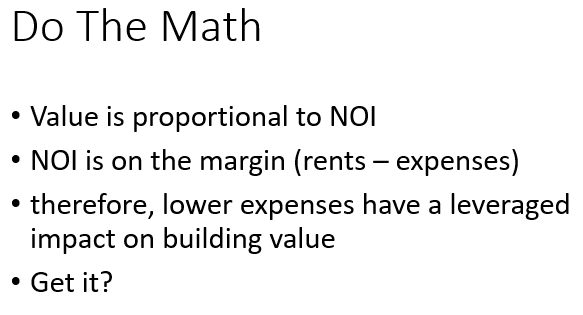San Francisco was one of the first cities in the U.S. to require mandatory, periodic energy audits for existing building stock. While those of us who perform energy audits, initially saw the requirements as a good opportunity, for a number of reasons mandatory audits have not been especially good for our industry, nor have they really achieved their policy objectives of lowering energy use in existing. building stock. Why? For a couple of reasons:
- In both markets where I’m familiar with mandatory audits (San Francisco and New York City), the regulatory pressure has forced a race to the bottom in terms of cost and quality of audits. Many customers simply want to meet their obligation at the lowest cost, and that often results in an audit that meets the letter of the law but has no real value.
But perhaps more importantly…
- Engineers who conduct energy audits haven’t focused on packaging our recommendations in ways that align with the needs of the real estate business.
As someone who’s spent a big chunk of my professional career doing energy audits, and advocating for better audit practices, and standards, I have a lot vested in how energy audits are done. And it’s with some humility that I admit point #2 above – we haven’t really packaged energy audits in terms that are the most compelling to building owners, namely, how we can increase profit, net operating income, and ultimately, the value of a building.

Hat’s off to Lane Burt (Ember Strategies) and Barry Hooper (SF Dept of the Environment), for pioneering a revised approach – looking at energy, capital assessment, deferred maintenance and their impact on the bottom line as a way of motivating building owners in terms that they value. Their thesis is that standard energy audits:
- Don’t present results in ways that are consistent with real estate practice
- Don’t show the hidden costs of inaction; and
- Focus on a snapshot in time, rather than on a realistic plan for the site.
As a result, they’ve developed a pilot approach, where building owners can meet the City’s mandatory energy audit ordinance with an alternative compliance path that better meet the needs of commercial building owners, in terms that they make business decisions.
One of the ways that they are “shifting the goalposts” is by de-emphasizing simple payback and highlighting the “cost of doing nothing.” In most energy audit reports, we gloss over the cost of doing nothing by taking it as the baseline upon which other measures are judged. What gets obscured by that approach are the very real costs of deferred maintenance, which costs energy, lowers your net operating income (NOI), and therefore lowers your building value. The impacts can be profound.
I’ve long said that simple payback is a poor way to present energy efficiency measures. (and I’ll invite @MarkJewell to chime in here). Simple payback communicates that, if you spend a bunch of money now, and believe your auditor that the savings are real, in a few years you’ll pay off your investment. Or, in other words, be back where you started. How motivating is that?
What Lane and Barry are emphasizing in the SEA approach is that these decisions impact the value of your building, and “do nothing” might be costing you in the long run vs. early retirement of older equipment. They do this by cooperating with the building owner to develop a capital plan, including deferred maintenance and retro-commissioning. They then value those decisions over time, comparing different scenarios, to home in on an approach that does the most for your building’s value.
The other way in which the SEA approach is better than most audits is the emphasis on capital planning over time. Energy audits have traditionally been a “snapshot in time” focused on what measures are cost effective at this moment. We’ve largely ignored issues of long-term capital planning and realistic projections of equipment lifetime. So, while your 30 year-old-chiller seems to be running fine, if you run it to failure you; 1) may be lowering the value of your building through excess operating expenses, 2) run the risk of downtime when it fails, and; 3) risk getting stuck with equipment you buy through a harried procurement purchase with little time to evaluate options.
Instead the SEA approach looks at all your major equipment and forecasts reasonable equipment lifetimes, similar to an abbreviated property condition assessment report. This approach then let’s you evaluate the timing of that replacement to optimize the value of the property now, and plan for capital replacements based upon your own property sales strategy, and the existing equipment life.
We’re pretty excited by this alternative compliance pathway for San Francisco and are looking forward to applying it on our client’s portfolios. And, mandatory audit ordinance or not, I think there is much to be learned/borrowed from this approach. Want to know more? Have a building that you want to maximize the value of. Get in touch!
Like this post? Share it with your network on LinkedIn.


